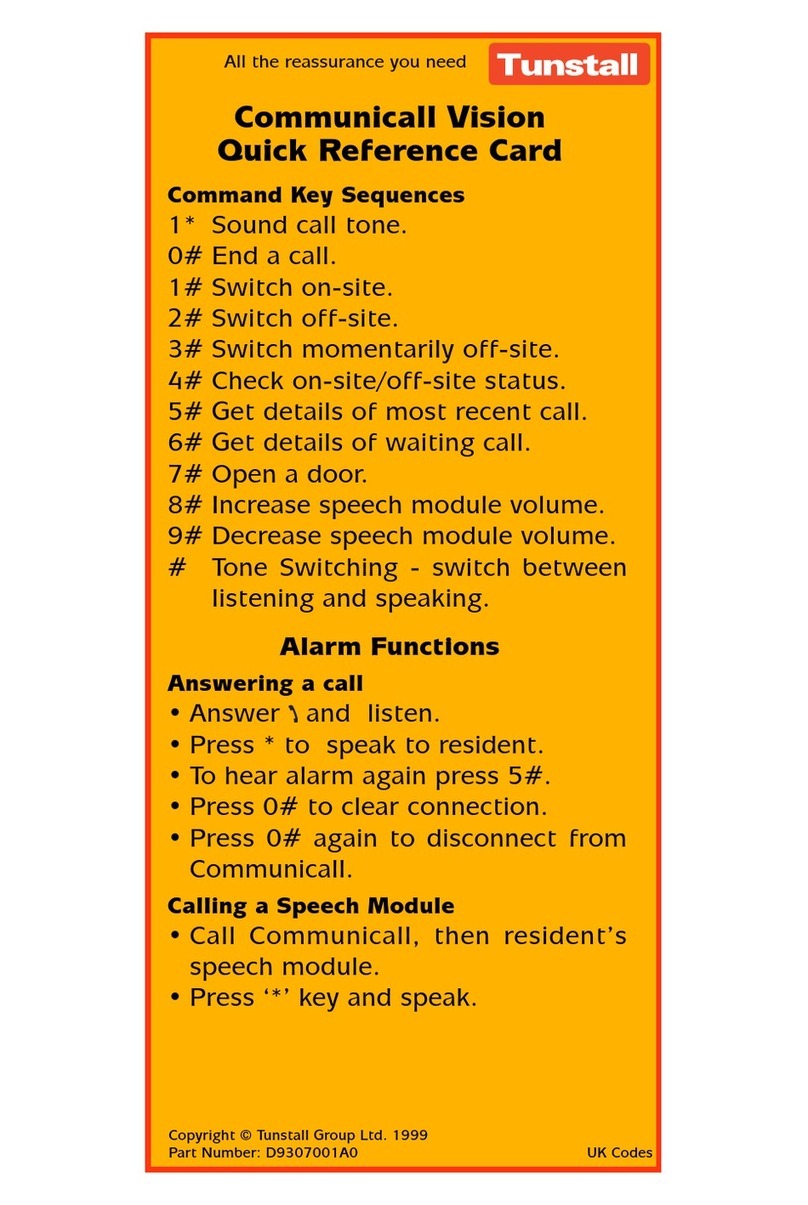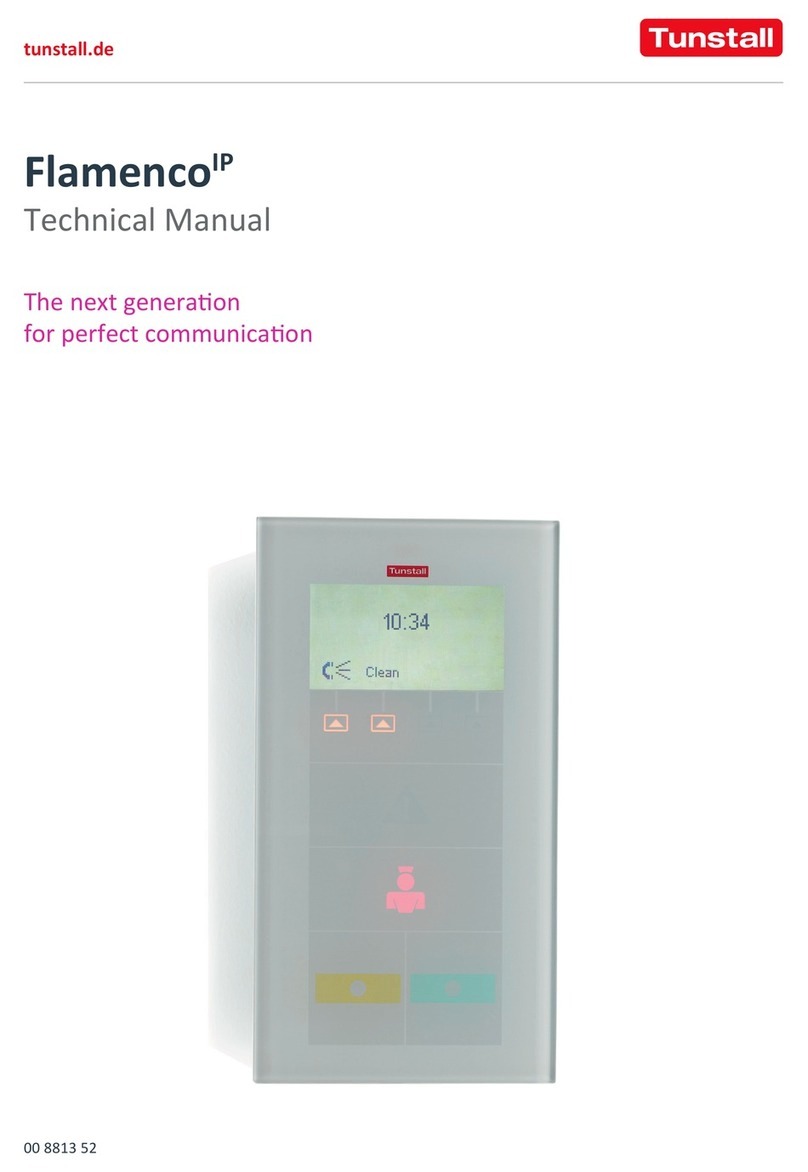
00 8801 69, 09/2017 (Rev. 5.0) - 9 -
© Tunstall GmbH, Orkotten 66, 48291 Telgte, Germany, www.tunstall.de
FR - Notice de configuration EN - Configuration Instructions
Régler le type de chambre
1. Sélectionner « Type chamb. » avec les touches fléchées
puis appuyer sur la touche circulaire.
2. Sélectionner le type souhaité avec les touches fléchées :
Chambre patient
Chambre patient avec une touche d'arrêt dans le Com-
Terminal pour appel WC
Office (appels d'urgence sont signalisés comme des
appels normaux)
Chambre d'enfants (pas de touche pour activer le se-
cret dans le ComTerminal, secret ARRÊT)
Mode Terminal (touches et afficheur dans le ComTer-
minal hors service)
3. Appuyer sur la touche circulaire pour régler la sélection.
Régler le nombre RAN (0 – 30)
Nombre RAN = nombre d'appareils de chambre (blocs, bloc
prises, hublots de chambre, etc.) raccordés via RAN (pas de
poire d'appel).
1. Sélectionner « RAN » avec les touches fléchées puis ap-
puyer sur la touche circulaire.
2. Sélectionner « Nombre RAN » avec les touches fléchées
puis appuyer sur la touche circulaire.
3. Sélectionner le nombre RAN de la chambre avec les
touches fléchées.
4. Appuyer sur la touche circulaire pour régler la sélection.
Régler l'adresse de chambre (0 – 110)
1. Sélectionner « Adresse » avec les touches fléchées puis
appuyer sur la touche circulaire.
2. Sélectionner l'adresse souhaitée avec les touches flé-
chées.
3. Appuyer sur la touche circulaire pour régler la sélection.
Selecting the room type
1. Mark “Room type” using the arrow keys. Then press the
circle key.
2. Mark the desired room type using the arrow keys:
Patient room
Patient room with cancel key for WC call at ComTermi-
nal
Staff room (emergency calls are signalled as normal
calls)
Children‘s room (no key to switch the privacy function at
ComTerminal, Privacy OFF)
Connection terminal (keys and display at ComTerminal
non-operational)
3. Press the circle key to set the selection.
Setting of RAN number (0 – 30) (Room Area Network)
RAN number = Number of devices in the room (switches, con-
nection sockets, room lamps, etc.) that are connected via
RAN. (No pear push switch).
1. Mark “RAN” using the arrow keys. Then press the circle
key.
2. Mark “RAN number” using the arrow keys. Then press the
circle key.
3. Mark the desired RAN number using the arrow keys.
4. Press the circle key to set the selection.
Setting of room address (0 – 110)
1. Mark “Address” using the arrow keys. Then press the cir-
cle key.
2. Mark the desired room address using the arrow keys.
3. Press the circle key to set the selection.
3. Réglages en option
Les points menu restants fournissent des réglages optionnels.
Réglez-les si nécessaire. Exemples :
Touches
Avertissement ! Les touches désactivées ne sont pas dispo-
nibles pour le personnel de soins et les patients !
Touche d‘alarme
En réglage usine, la touche d'alarme du ComTerminal est
opérationnelle et est déclenchée par une pression brève.
Lorsqu'il y a un danger que la touche d'alarme soit déclenchée
accidentellement, il peut s'avérer utile de régler le temps de
retardement (2 ou 3 secondes). Cela signifie que l'alarme est
seulement déclenchée lorsque la touche a été appuyée pen-
dant 2 ou 3 secondes.
Attention ! Le réglage d'un temps de retardement n'est pas
conforme à la norme allemande DIN VDE 0834. Un temps de
retardement ne peut être réglé que si la conformité à la norme
DIN VDE 0834 n'est pas requise.
Dans des cas exceptionnels fondés, il est possible de désac-
tiver la fonction de la touche d'alarme.
Remarque ! La touche d'alarme est seulement active lorsque
la présence dans la pièce est activée.
Touche de présence 1 / touche de présence 2
En réglage usine, les deux touches de présence du ComTer-
minal sont opérationnelles.
Dans des cas exceptionnels fondés, il est possible de désac-
tiver la fonction des touches.
3. Entering of optional settings
The remaining menu items provide optional settings. Set
these if required. Examples:
Key Function
CAUTION! Switched off keys are not available for nursing
staff!
Alarm Key
With the factory settings the alarm key on the ComTerminal is
operational and is initiated by pressing it.
If there is the risk, that the alarm button is initiated inadvertent-
ly, it might make sense to set a delay time (2 or 3 seconds). In
that case the alarm will be initiated after the alarm key has
been pressed and then hold for 2 or 3 seconds.
CAUTION! Setting a delay time does not comply with the Ger-
man standard DIN VDE 0834. A delay time may only be set,
where compliance with the DIN VDE 0834 is not required.
In well-founded exceptional cases you can switch of the alarm
key function.
NOTE! Die Alarm Key is only active while the staff presence
is switched on in the room.
Presence Key 1 / Presence Key 2
With the factory settings the presence keys on the ComTermi-
nal are operational.
In well-founded exceptional cases you can switch of the key
function for these keys.































